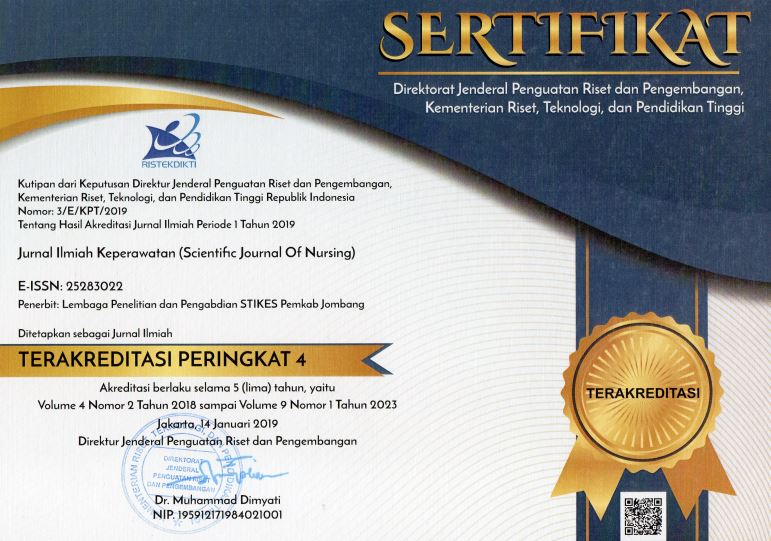HUBUNGAN ASUPAN MAKANAN DAN AKTIVITAS FISIK DENGAN KEJADIAN MALNUTRISI PADA REMAJA DI WILAYAH KECAMATAN SENEN
A Correlation between Food Intake and Physical Activity with the Incidence of Malnutrition in Adolescents in the Senen District Area
DOI:
https://doi.org/10.33023/jikep.v9i2.1570Keywords:
Kata Kunci: Remaja, asupan nutrisi, aktivitas fisik, malnutrisiAbstract
Pendahuluan: Malnutrisi pada remaja masih menjadi masalah global yang terjadi baik di negara berkembang maupun di negara maju di dunia. Strategi pencegahan dan penanganan berbagai bentuk malnutrisi pada remaja ditetapkan oleh Unicef, salah satu diantaranya adalah melalui program nutrisi dan aktivitas fisik pada remaja. Tujuan: Menegetahui hubungan asupan makanan dan aktivitas fisik dengan kejadian malnutrisi pada remaja di wilayah kecamatan senen. Metode: Penelitian kuantitatif dengan desain deskriptif analitik menggunakan pendekatan cross sectional. Tehnik pengambilan sampel dengan purposive sampling. dengan jumlah sampel sebanyak 110 remaja. Hasil: Terdapat hubungan asupan makanan dengan kejadian malnutrisi p value 0,037, analisis faktor risiko didapatkan nilai OR 1.385, CI 95%, (1,020-1.808), artinya remaja yang memiliki asupan makanan tidak baik berisiko 1.385 kali memiliki status gizi tidak normal dibandingkan remaja dengan asupan nutrisi yang baik. Tidak terdapat hubungan antara aktivitas fisik dengan kejadian malnutisi pada remaja p value 0,351. Simpulan: Status gizi pada remaja dapat ditingkatkan melalui asupan makanan yang baik sesuai pedoman gizi seimbang dan aktivitas fisik sebagai faktor penyeimbang untuk mencegah malnutrisi.
Downloads
References
Christian, P., & Smith, E.R. (2018). Adolescent undernutrition: Global burden, physiology, and nutritional risks. Annals of Nutrition & Metabolism. 72 (4), 316-322
Deren, K., Nyankovskyy, S., Nyankovska, O., Luszczki, E., Wyszynska, J., Sobolewski, M., & Mazur, A. (2018). The prevalence of underweight, overweight and obesity in children and adolescents from Ukraine. Scientific Reports. 8 (3625), 1-4.
Februhartanty, J., Rachman, P.H., Ermayani, E., Dianawati H., & Harsian, H. (2016). Gizi dan kesehatan remaja: Buku pegangan dan kumpulan rencana ajar untuk guru sekolah menengah pertama. Jakarta: SEAMEO RECFON, Kemendikbud RI.
Fleming, C., Oliveira, J.D.D., Sharma, D., Schmied, V., La la, G., Booher, P.K., Escamilla, R.P., & Third, A. (2021). Drivers of food choice, barriers to healthy eating and a call to action from adolescents to improve nutritional intake across 18 countries. Current Developments in Nutrition. 5(2) 643
Gaylis, J.B., Levy, S.S., & Hong, M.Y. (2020). Relationships between body weight perception, body mass index, physical activity, and food choices in Southern California male and female adolescents. International Journal of Adolescence and Youth. 25 (1), 264-275.
Haddad, L., Cameron, L., Barnett, I. (2015). The Double bur- den of malnutrition in South East Asia and the Pacific: priorities, policies and politics. Health Policy Plan. 30 (9), 1193-206.
Haidar, A., Ranjit, N., Archer, N., & Hoelscher, D.M. (2019). Parental and peer social support is associated with healthier physical activity behaviors in adolescents: a cross-sectional analysis of Texas School Physical Activity and Nutrition (TX SPAN) data. BMC Public health. (19;640), 1-9.
Kementerian Kesehatan RI. (2018). Hasil Riset Kesehatan Dasar (Riskesdas) 2018. Jakarta: Badan Penelitian dan Pengembangan Kesehatan Kementerian RI.
Kementrian Kesehatan RI. (2019). Tabel ambang indeks massa tubuh (IMT). Jakarta: Indonesia.
Kusum, K., Rohilla, Vasantha, C., Kalyani, & Babbar, P. (2021). Prevalence and contributing factors for adolescent obesity in present era: Cross sectional Study Seema. Journal of Family Medicine and Primary Care. 10 (5), 1890-1894.
Rah, J.H., Boonstra, A.M., Agustina, R., Zutphen, K.S.V., & Kraemer, K. (2021). The triple burden of malnutrition among adolescents in Indonesia. Food and Nutrition Bulletin. 42(1S), 4S-8S.
Sheoran, S., Arora, S., & Kumari, M. (2021). Nutritional status of teenagers in urban area in India. Journal Multidisciplinary Peer Review Journal, 7(4). 33-3678
Reinehr, T. (2018). Long-term effects of adolescent obesity: time to act. Nature Review; Endocrinology. (14), 183-188.
United Nations Children’s Fund (UNICEF). (2021). Programming guidance: Nutrition in middle childhood and adolescence. UNICEF: New York, NY.
United Nations Children’s Fund (UNICEF). (2021). Social and behavioural change communication strategy: Improving adolescent nutrition in Indonesia. UNICEF, Jakarta
Veronika, A.P., Puspitawati, T., & Fitriani Ayu. (2021). Associations between nutrition knowledge and nutritional status of adolescents. J Public Health Res. 10(2), 1-5.
WHO, & CDC. (2015). Indonesia- global school-based student health survey 2015. Unicef: Jakarta
WHO. (2021). Malnutrtion. Retrieved from https://www.who.int › Newsroom › Fact sheets › Detail; 9Mei 2021
Published
How to Cite
Issue
Section
Authors who publish with Jurnal Ilmiah Keperawatan (Scientific Journal of Nursing) agree to the following terms:
- Authors retain copyright and grant Jurnal Ilmiah Keperawatan (Scientific Journal of Nursing) the right of first publication with the work simultaneously licensed under a Creative Commons Attribution 4.0 International License that allows others to remix, adapt and build upon the work with an acknowledgment of the work's authorship and of the initial publication in Jurnal Ilmiah Keperawatan (Scientific Journal of Nursing).
- Authors are permitted to copy and redistribute the journal's published version of the work (e.g., post it to an institutional repository or publish it in a book), with an acknowledgment of its initial publication in Jurnal Ilmiah Keperawatan (Scientific Journal of Nursing).









